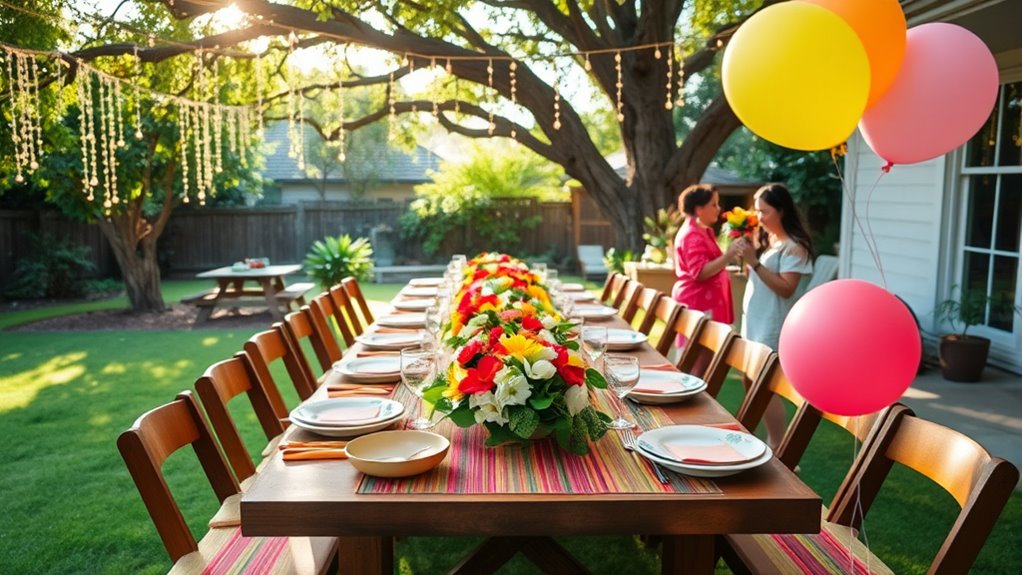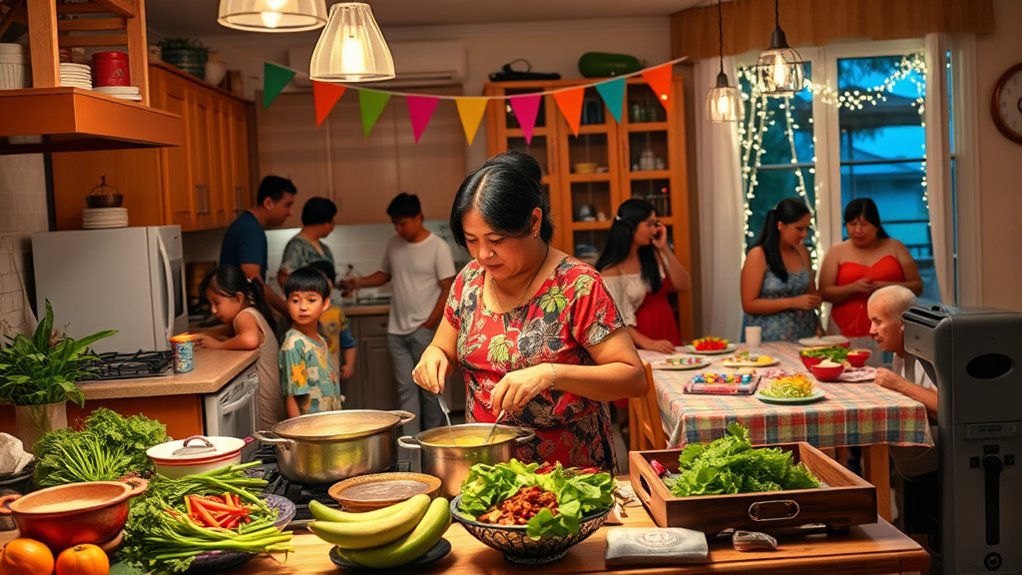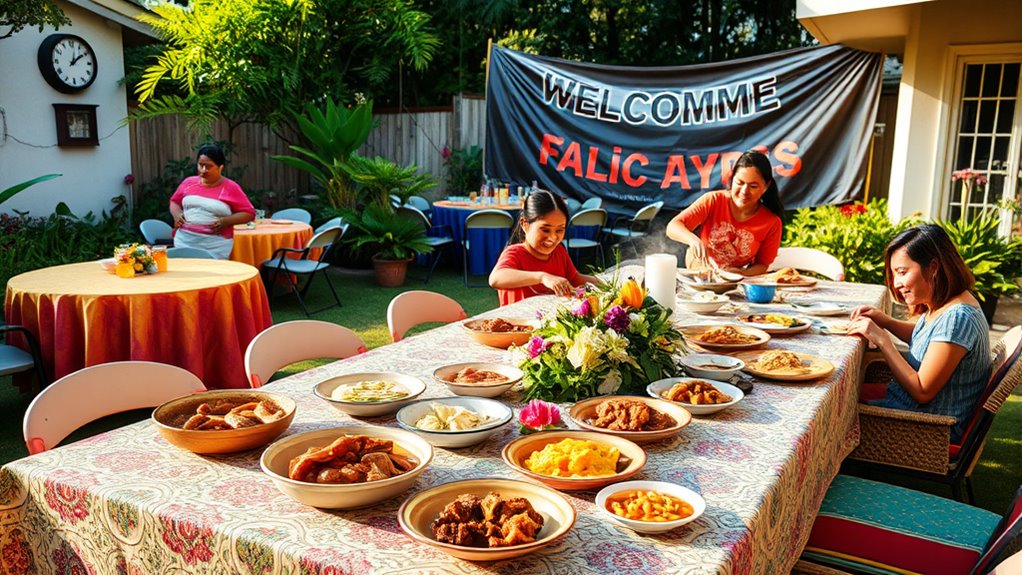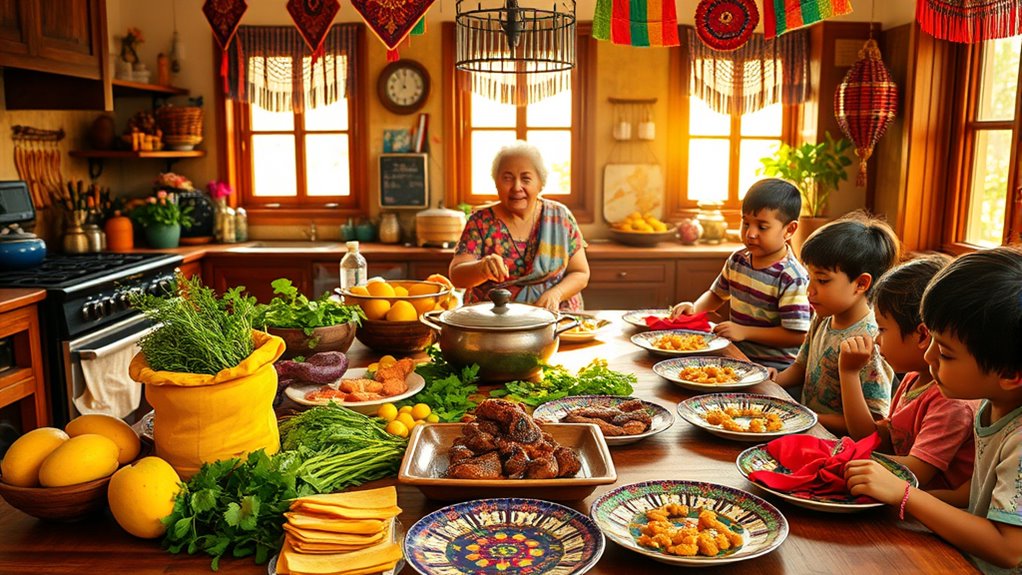To prepare for a Filipina family gathering, start by understanding family dynamics and the importance of respect for elders. Plan a menu with traditional dishes like Adobo and Lechon, ensuring a good balance of flavors. Set up cozy decorations and soft lighting to create an inviting atmosphere. Organize fun games and karaoke for entertainment. Finally, remind guests about etiquette, like RSVPing and expressing gratitude. There’s plenty more to contemplate, so keep exploring for a successful gathering!
Key Takeaways
- Plan a menu featuring traditional dishes like Adobo, Lechon, and Pancit, served family-style with essential condiments.
- Choose a festive color scheme and incorporate ambient decorations like string lights and seasonal centerpieces for a welcoming atmosphere.
- Organize traditional games and karaoke sessions to engage guests and promote cultural participation.
- Encourage respectful interactions and gratitude during meals, emphasizing the importance of thanking hosts and elders.
- Ensure guests RSVP for proper preparation and establish house rules for a harmonious gathering.
Understanding Family Dynamics

Understanding family dynamics is vital, especially when preparing for a Filipina family gathering.
You’ll notice that family units often include multiple generations living together, which fosters close relationships. The eldest male, usually the father or grandfather, holds significant authority, guiding decisions and actions. Extended family members like aunts and uncles also play important roles, encouraging respect and loyalty among everyone involved. Additionally, understanding the impact of narcissistic behavior can help you navigate complex family interactions effectively. Emotional dysregulation can also manifest in these gatherings, prompting reactions that may require careful handling. This can be particularly important when discussing cooperative co-parenting plans, as it helps maintain harmony among family members. It’s essential to be aware of gaslighting tactics that can arise in family discussions, which may contribute to misunderstandings.
While traditional roles are evolving, with both parents sharing responsibilities, the core values of respect for elders and strong familial bonds remain intact. As you navigate these dynamics, remember that open communication is key. Embrace the spirit of togetherness, as it strengthens connections and guarantees everyone feels valued during gatherings. Additionally, recognizing the importance of strong demand and absorption in other contexts, like cryptocurrency, can help you appreciate how family ties similarly influence relationships and support systems.
Planning the Menu

When planning the menu for a Filipina family gathering, it’s essential to focus on traditional dishes that highlight the rich flavors of Filipino cuisine. Include crowd-pleasers like Adobo, Lechon, and Pancit. To elevate your culinary experience, consider exploring global flavors that can complement the traditional offerings.
Organize your dishes into categories such as rice dishes, soups, pulutan (snacks), fiesta food, and desserts. Serve everything family-style, ensuring there’s plenty of white rice. Don’t forget key condiments like vinegar, fish sauce, and calamansi to enhance the flavors. To create a balanced menu, mix sweet, sour, salty, and umami elements. Additionally, consider incorporating cozy textiles to create a warm atmosphere where everyone can enjoy the meal together. Using farmhouse charm elements in your table setting can further enhance the inviting feel of the gathering.
Organize your meal into categories like rice dishes, soups, and desserts, and serve everything family-style with ample white rice.
As you prepare, consider the cultural significance of food, symbolizing unity and togetherness, while also planning for leftovers to enjoy later. Your thoughtful menu will surely make the gathering memorable.
Coordinating Decorations and Setup

After you’ve planned the menu, it’s time to create an inviting atmosphere that complements the delicious food.
Start by choosing a color scheme, like classic red and green or a tropical theme, to set the tone. Use string lights or lanterns for soft lighting, enhancing your indoor ambiance.
For table decorations, incorporate seasonal centerpieces with flowers or decorative vases, ensuring they’re safe for children.
If you’re using outdoor spaces, arrange cozy seating and picnic setups with blankets and cushions. Utility carts can help transport snacks easily.
Finally, include ambient lighting to keep the party going into the evening.
These thoughtful decorations will make everyone feel welcome and excited to celebrate together.
Organizing Activities and Entertainment

To create a memorable family gathering, you’ll want to organize a mix of activities and entertainment that appeals to everyone. Incorporate classic Pinoy parlor games like Newspaper Dance and Bring Me, along with a Calamansi Relay for some friendly competition.
Don’t forget a Polvoron Challenge for dessert lovers! Embrace cultural engagement by encouraging guests to wear traditional outfits and serving Filipino cuisine.
Plan a karaoke session for family sing-alongs, and consider organizing a ballroom dance or cultural performances for added flair. Make sure activities cater to all ages, from a kids’ play area to senior-friendly games.
Finally, consider using technology for interactive games and virtual participation, keeping everyone connected and entertained.
Ensuring Proper Guest Etiquette

Guaranteeing proper guest etiquette at a Filipina family gathering is essential for creating a warm and respectful atmosphere. Start by encouraging guests to RSVP, helping you prepare adequately.
As guests arrive, establish clear house rules, including trash disposal and restroom etiquette. Promote respectful interactions, especially between younger and older family members, and educate everyone on cultural practices to enhance understanding.
During meals, emphasize gratitude—use phrases like “Salamat” before and after eating. Ascertain elderly guests have preferred seating and highlight the importance of sharing food as a symbol of hospitality.
After the meal, encourage guests to thank the hosts and express their satisfaction, fostering an environment of appreciation and respect.
Managing Logistics and Timing

While planning a Filipina family gathering, managing logistics and timing is essential for a smooth experience.
First, consider transportation options like buses, jeepneys, or tricycles, especially in urban areas where traffic can slow things down. Rely on public transport to navigate unfamiliar areas efficiently.
Booking accommodations ahead of time is vital, particularly due to the Philippines’ geographical challenges. Family homes often serve as great options to cut costs.
Make sure to schedule events to avoid peak travel times, and engage local services for food delivery or catering to streamline logistics.
Finally, be flexible with timing, allowing buffer periods between activities to accommodate any unexpected delays or changes in plans.
Embracing Cultural Traditions

Embracing cultural traditions during a Filipina family gathering not only enriches the experience but also strengthens bonds among family members.
Centered around meals, the dining table becomes a space for connection, laughter, and storytelling. You’ll likely enjoy traditional dishes like lechón and lumpia, which highlight the significance of food in your cultural identity.
Participating in kamayan, or eating with your hands, adds a communal touch to the meal, fostering togetherness.
Celebrations often include festive music, gift-giving, and showcasing traditional crafts, all of which reinforce your family’s heritage. Moreover, these gatherings can serve as a way to enhance emotional resilience, helping family members cope with challenges and strengthen their mental wellbeing.
Frequently Asked Questions
What Gifts Should I Bring for the Host Family?
When you’re considering gifts for the host family, think about unique items that reflect their culture and preferences.
Quality alcohol, luxury perfumes, or fun gift vouchers are great options. You might also bring imported cookies or local delicacies to share.
Don’t forget to include thoughtful touches, like personalized keychains or beautifully wrapped items.
It’s the thought that counts, so focus on what would make them feel appreciated and valued.
How Can I Involve Children in the Preparations?
Imagine your kids taking charge like mini-chefs on a cooking show! To involve them in preparations, assign fun tasks like decorating or setting the table.
Encourage creativity by letting them arrange desserts or pick games. Explain their roles clearly, and offer positive feedback to keep them excited.
With a kid-friendly atmosphere featuring stories or cultural performances, they’ll feel engaged and connected. This way, everyone contributes to the gathering’s joy!
What Attire Is Appropriate for a Family Gathering?
For a family gathering, you’ll want to choose attire that reflects the occasion’s formality and cultural significance.
Men often wear a Barong Tagalog, while women may opt for a Baro’t Saya. Lightweight fabrics like piña or jusi keep you comfortable in warm weather.
Consider the venue and family traditions, ensuring your outfit honors cultural heritage and adds to the gathering’s festive ambiance.
Comfort and respect for the occasion should guide your choice.
How Do I Handle Dietary Restrictions Among Guests?
To handle dietary restrictions among your guests, start by asking specific questions when inviting them.
Create a menu that offers a variety of options, like gluten-free, vegetarian, and vegan dishes, to guarantee everyone can enjoy the meal.
Clearly label each dish with its ingredients and consider separate serving utensils to prevent cross-contamination.
Encourage an open dialogue, allowing guests to voice their needs and preferences, making sure everyone feels included and safe.
What Should I Do if I Arrive Late?
If you arrive late, don’t stress too much!
Imagine walking into a vibrant gathering, laughter filling the air, and people smiling as they notice your arrival.
Politely let the host know you’re running behind, and when you get there, dress well to show respect.
Bring a small gift, like homemade treats, as a thoughtful gesture.
Once inside, greet the elders with “mano po,” and enjoy the warm hospitality that awaits you.
Conclusion
Preparing for a Filipina family gathering is like orchestrating a beautiful symphony; each element plays an essential role in creating harmony. By understanding family dynamics, planning the menu, and embracing cultural traditions, you’ll set the stage for a memorable event. Don’t forget to coordinate activities and follow proper etiquette to guarantee everyone feels included. With a little effort and love, you can make the gathering a joyful celebration that resonates in everyone’s hearts long after it ends.









